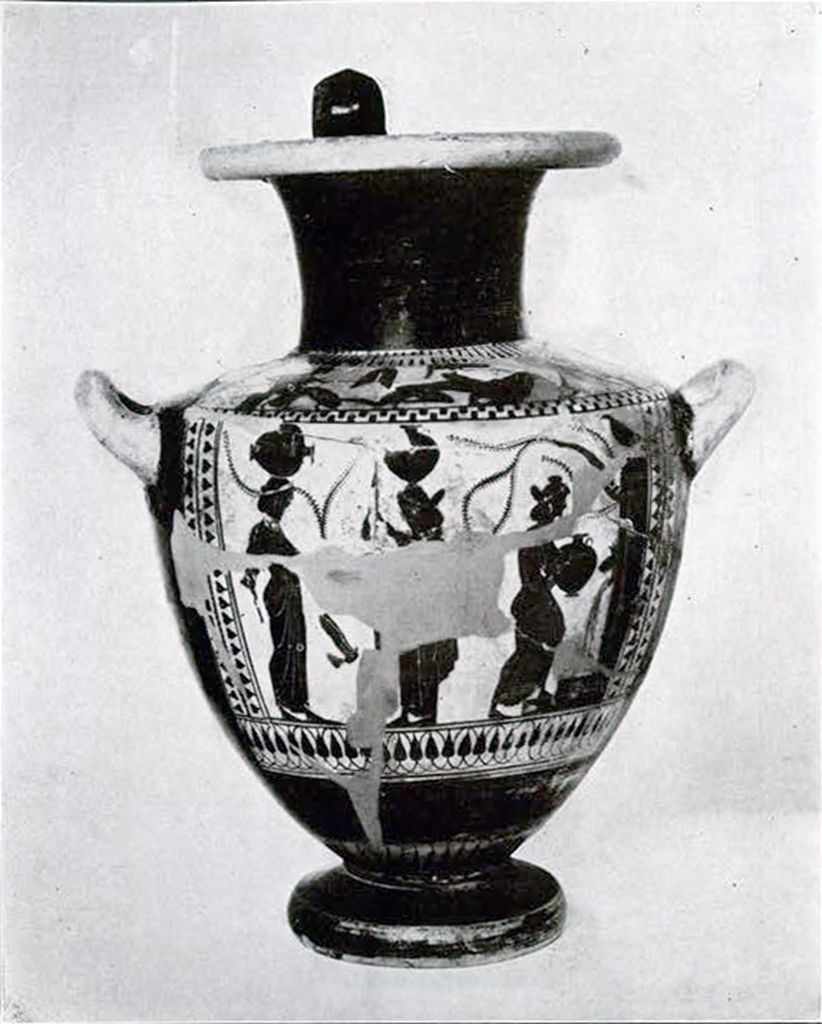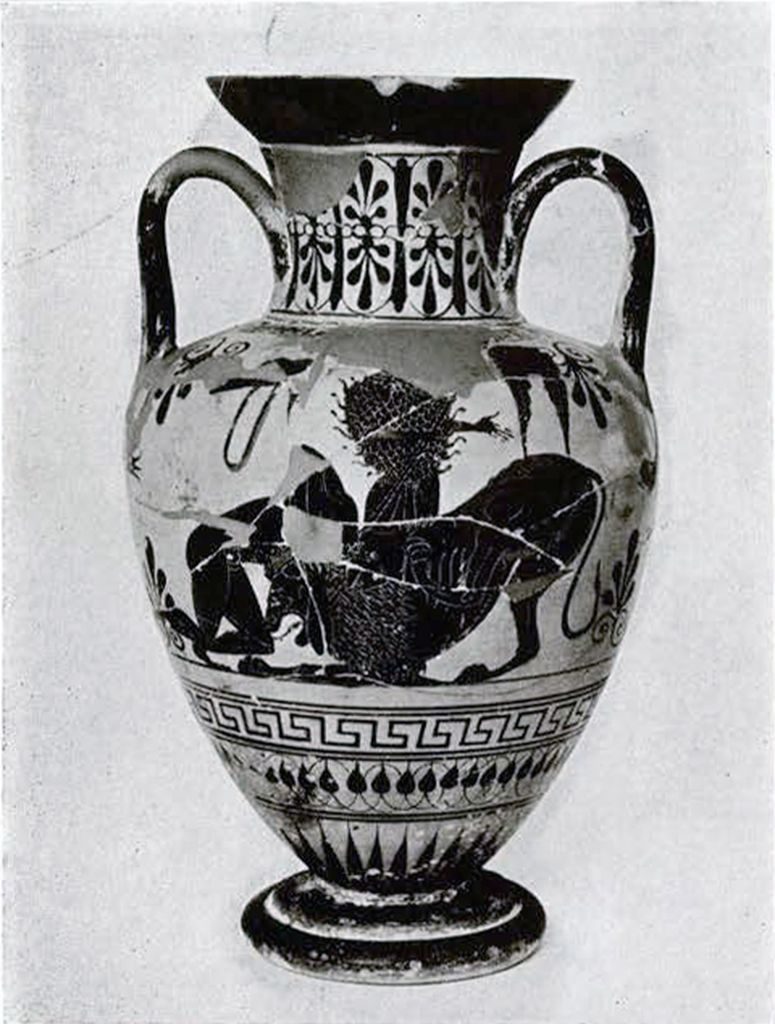The recent acquisition of an Attic black-figured amphora by the Museum, with a painting of Herakles fighting the Amazons, has made it seem expedient to collect together the vases in the Museum that portray exploits of this popular hero, and to give illustrations of all previously unpublished specimens.
A Newly Acquired Amphora
The amphora recently received was formerly in the Borelli Bey Collection, which was dispersed in Paris in 1913. In the Sale Catalogue, it is numbered 221, and a photograph of it is published. The writer of the catalogue, in describing it, calls it a work of the painter Exekias; this, though possible, is not likely.
On the obverse side (Fig. 52) we see Herakles, sword in hand, attacking two Amazons. He wears his lion’s skin over a short chiton. One of the Amazons, who is fully armed, wearing a helmet and breastplate, and a sword at her side, and carrying a shield, with the device of a tripod, and a spear, has been stopped in her flight by the hero, who has overtaken her, and forced her on one knee. Her sex is betrayed by the treatment of the flesh parts in white overcolor, a common method in the black figured technique for portraying women. From the right, the second Amazon, similarly armed, comes to her comrade’s rescue.
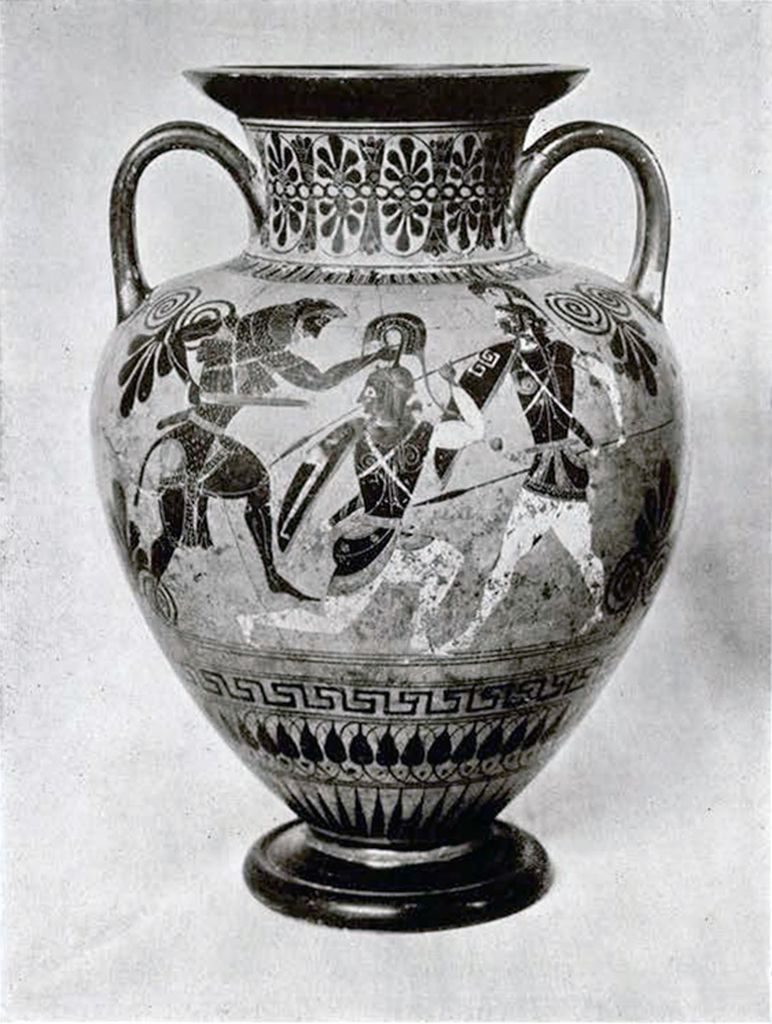
Museum Object Number: MS5467
Image Number: 2802
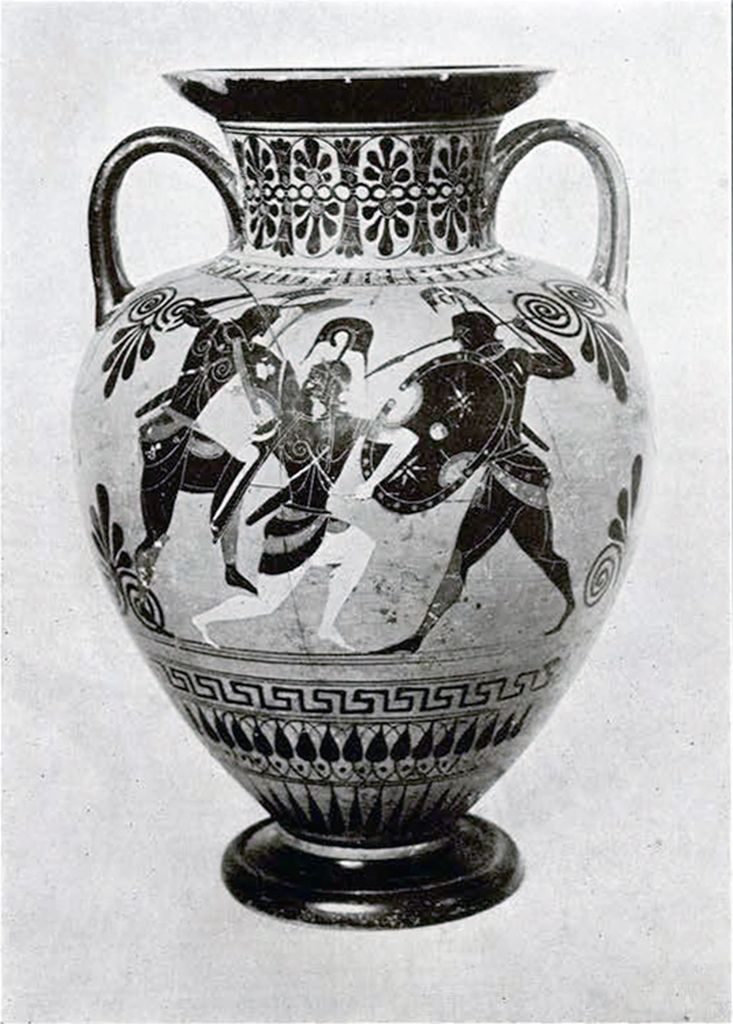
Museum Object Number: MS5467
Image Number: 2801
The reverse (Fig. 53) shows two Greeks attacking a fallen Amazon. The Amazon is in every respect identical to the one attacked by Herakles, even including the device on her shield. The two Greeks are fully armed; but the shields that they carry are of a different shape from that of the Amazon, being of the so-called “Boeotian” type. They also wear greaves, which are not worn by the Amazons on this vase.
A singular peculiarity is to be noticed in the helmet worn by the Greek on the left of this picture. His helmet is drawn apparently with two crests. Whether this is mere carelessness on the part of the vase painter, or whether, as some maintain, this is a crude attempt to draw the crest in full face, instead of in profile, is uncertain. Other examples are known, three of which have come to my notice.
On a black figured panel amphora, in the Louvre, No. F53, signed by Exekias, we see Herakles, in his combat with the triple bodied Geryon. One of the heads of Geryon is equipped with a helmet showing such a crest. This amphora is published among other places, by Gerhard, “Auserlesene Vasenbilder,” pl. 107.
Another black figured panel amphora, seen by Gerhard in the trade in Rome, and now lost, had a battle scene, in which one of the combatants wore such a helmet. This vase is published in “Auserlesene Vasenbilder,” pl. 208.
A red figured amphora in the Louvre, No. GI, signed by Andokides, shows a combat, in which one of the warriors wears such a helmet. Published in Furtwangler-Reichhold, “Griechische Vasenmalerei,” pl. 111.
Herakles and the Amazons
The battle with the Amazons is the ninth of the labors of Herakles for his uncle Eurystheus, King of Mycenae. It was to bring back to Eurystheus the girdle of Hippolyta, the queen of the country that these warrior women inhabited. In order to accomplish this feat, Herakles had to fight with them.
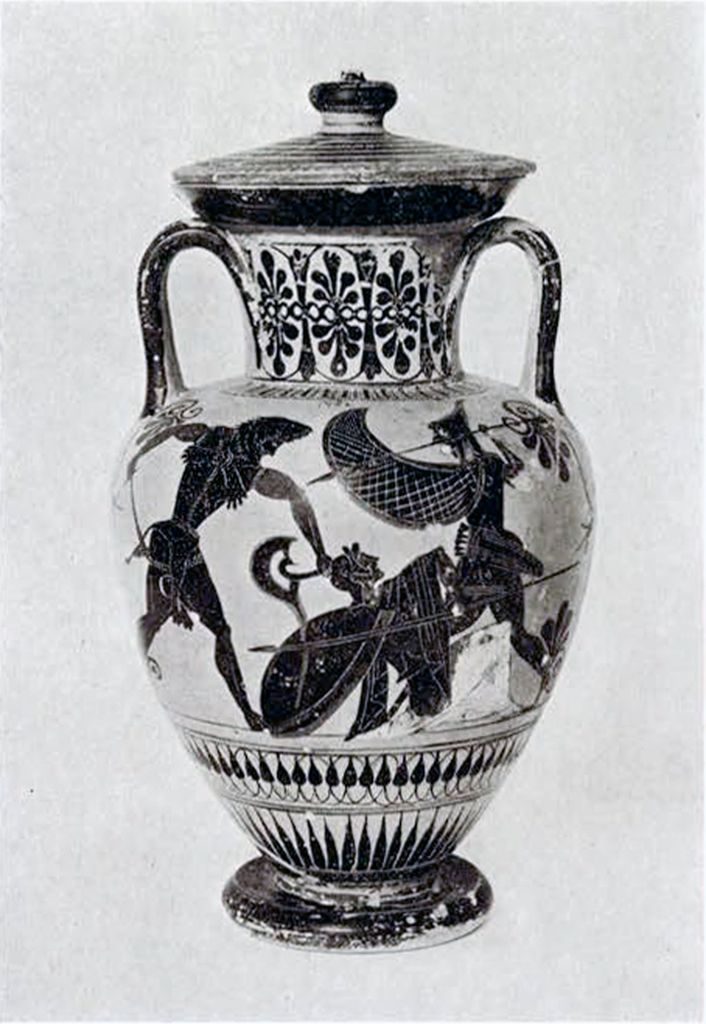
Museum Object Number: MS1752
Image Number: 2722

Museum Object Number: MS1752
Image Number: 2721
Next to the new amphora, the best example of this exploit in the Museum is painted on a black figured amphora, with a cover, found at Corneto in Etruria. This is one of the finest vases in the Museum’s possession: the preservation is very good, and the drawing is of the best period in the black figured technique, about 525 B.C., a little later probably than the newly acquired amphora. On the obverse (Fig. 54), Herakles attacks two Amazons. In this connection it should be said that, while in these two amphore there are only two Amazons with Herakles, three is the more common number on Greek vases in general. Herakles has dragged one of the Amazons to the ground, and grasps the crest of her helmet in his left hand, while he has his sword in his right. The Amazon tries to resist. The hero wears the lion’s skin over a short chiton; the Amazon is fully armed in the Greek fashion, and the nude parts of her body (face, arms and legs) are rendered in white.
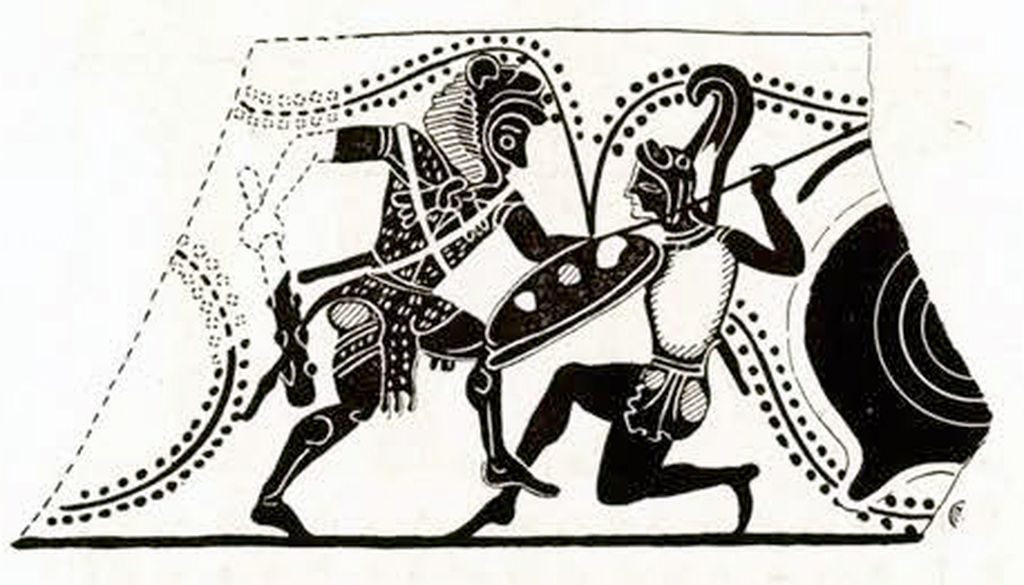
From the right the second Amazon comes to the defense of her comrade. She wears an Oriental costume, composed of a tight fitting, one piece garment, ornamented with spots, reaching from the neck to the ankles, and terminating in tight trousers, in the Persian manner. On her head she wears a Phrygian cap, and her face is rendered in white. A quiver is slung from her shoulders. Her right arm is drawn back, with her spear poised to thrust at Herakles, against whom she strides with great energy, and on her left arm is a crescent-shaped shield, with a checkered design, perhaps to represent wicker work.
On the reverse (Fig. 55) are two mounted Amazons, riding bare-back, towards the right, with two dogs. One of these Amazons wears Greek armor, the other, the Phrygian costume. Both carry two spears.
There is still another representation of this exploit, on a fragment of a black figured cup, found at Orvieto (Fig. 56). Here, between two eyes (we must undoubtedly supply an eye at the left), Herakles attacks an Amazon with his club.
Herakles and the Cretan Bull
This was the seventh of the labors that Herakles did for Eurystheus. The bringing of this famous bull from Crete to Mycenae was a favorite subject among the Greek vase painters, and the Museum possesses a fragment that may possibly show it.
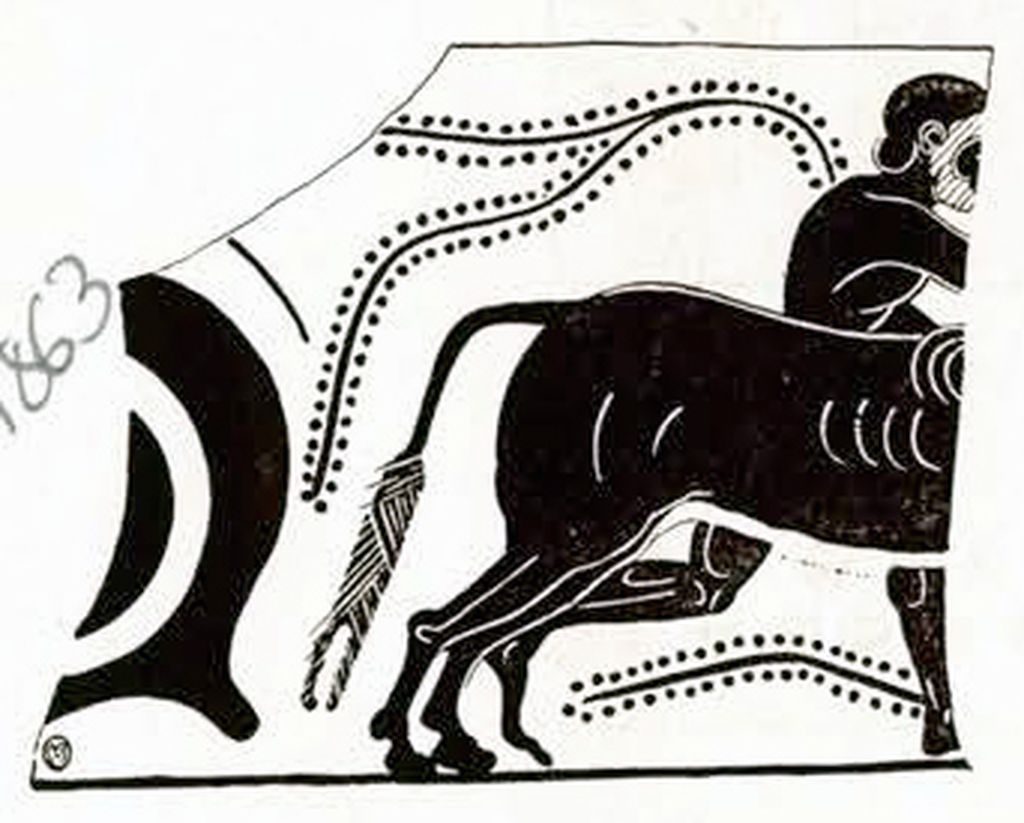
Museum Object Number: MS4863.1
This is a fragment of a small black figured cup, found at Orvieto, and probably part of the same vase as the Amazon fragment described above (Fig. 57). In the sherd we see a nude bearded man running with outstretched arms to the right, attempting to catch an animal running in the same direction. Unfortunately, only the hind parts of this animal are preserved; but it can be seen from their shape, and from the drawing of the tail, that it is a bull which the man is pursuing. The man is, therefore, trying to grasp the bull by the horns. This is very possibly a representation of Herakles and the Cretan Bull.
Herakles and the Erymanthian Boar
This was the fourth of the famous twelve labors of Heraides. In the Museum are fragments of an Attic black figured amphora, showing Herakles bringing the boar to Eurystheus, who in fear has thrown himself into a big pithos, or jar. The onlookers are Athena on the right, and Hermes on the left. These fragments are published in the MUSEUM JOURNAL, Vol. IV, 1913, p. 159, Fig. 137.
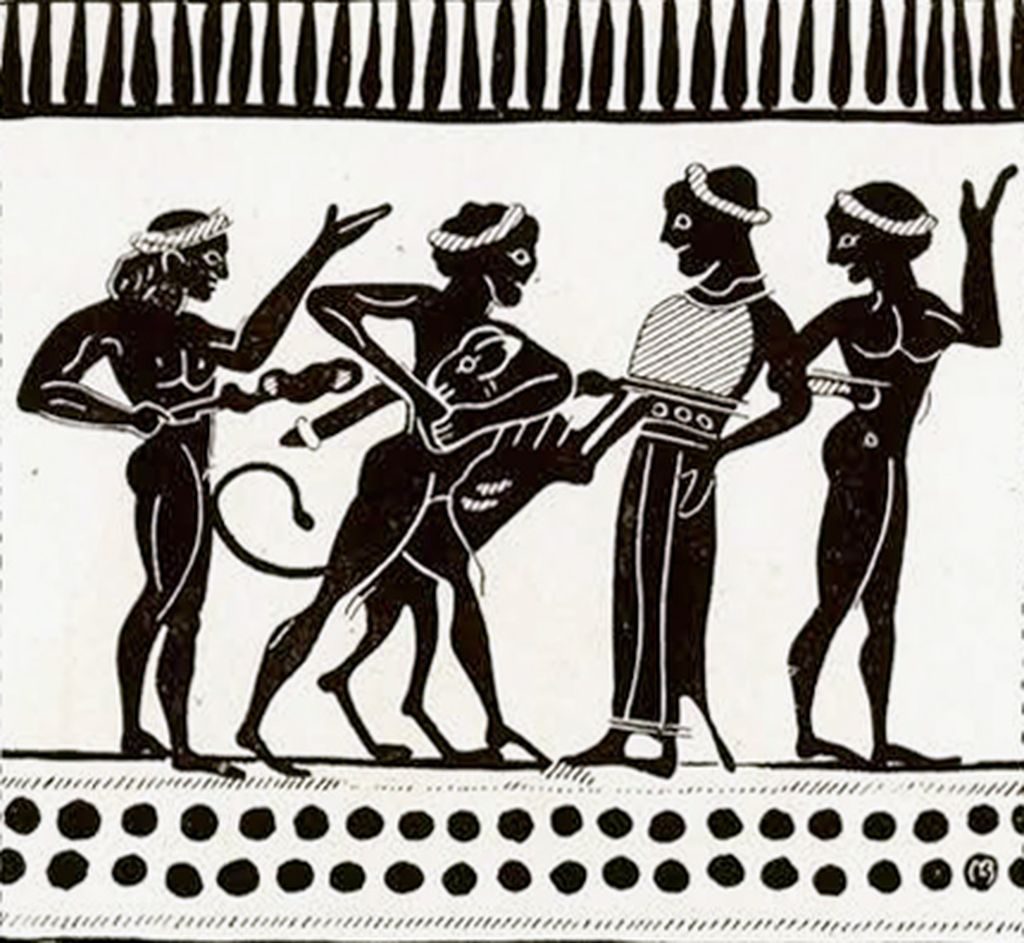
Museum Object Number: MS4802
The Apotheosis of Herakles, and the His Marriage with Hebe
After his death from the poisoned shirt of Nessos, Herakles was made a god, and conducted to Olympus. The usual mode in the black figured technique is to have him ride in a chariot driven by Athena and escorted by the other gods. A black figured hydria in this collection seems to show this subject. Athena is driving a chariot, and the man with her carries a club, and may well be Herakles, although he is not dressed in the lion’s skin. This vase is published in the MUSEUM JOURNAL, Vol. IV, 1913, p. 147, Fig. 127.
When Herakles was made a god, he was married to Hebe, the cup bearer of the gods. This marriage is portrayed on a very beautiful late red figured pyxis, or toilet box, recently acquired by the Museum, and published in the MUSEUM JOURNAL, Vol. VII, 1916, p. 270, Fig. 204, and p. 272, Fig. 205.
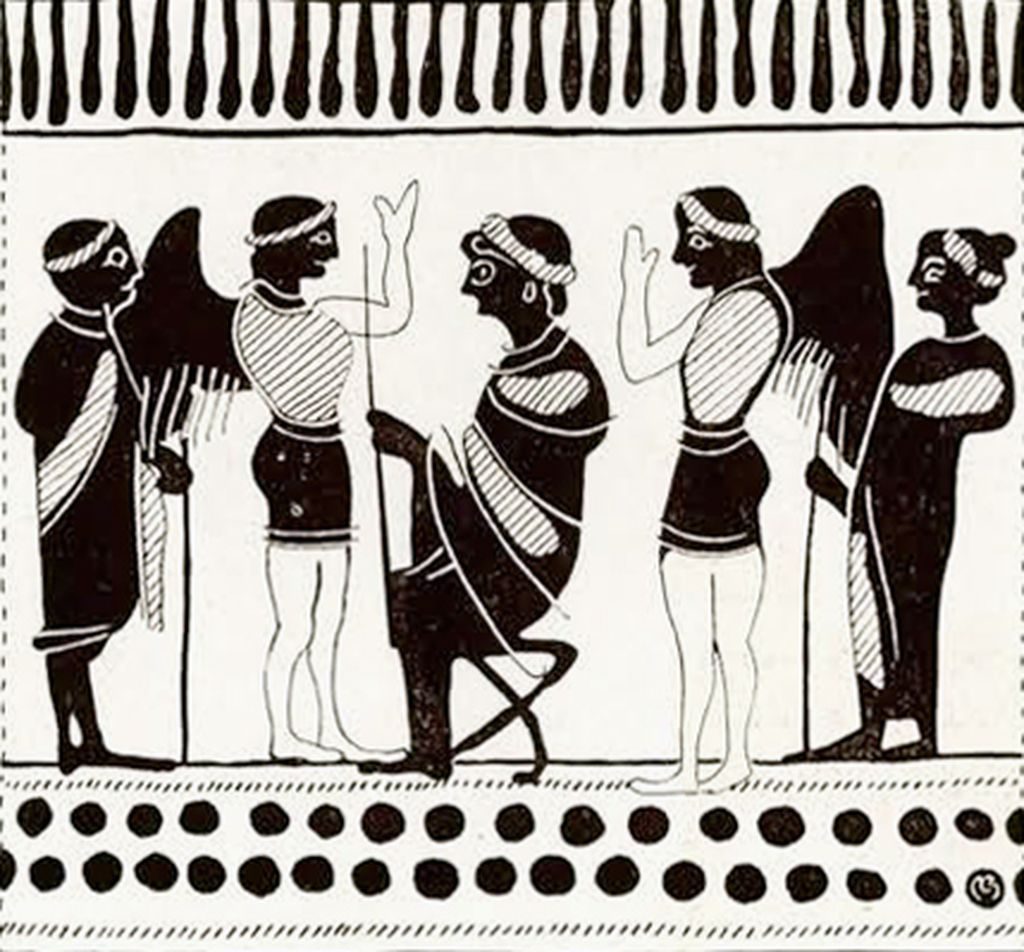
Museum Object Number: MS4802
Herakles and the Nemean Lion
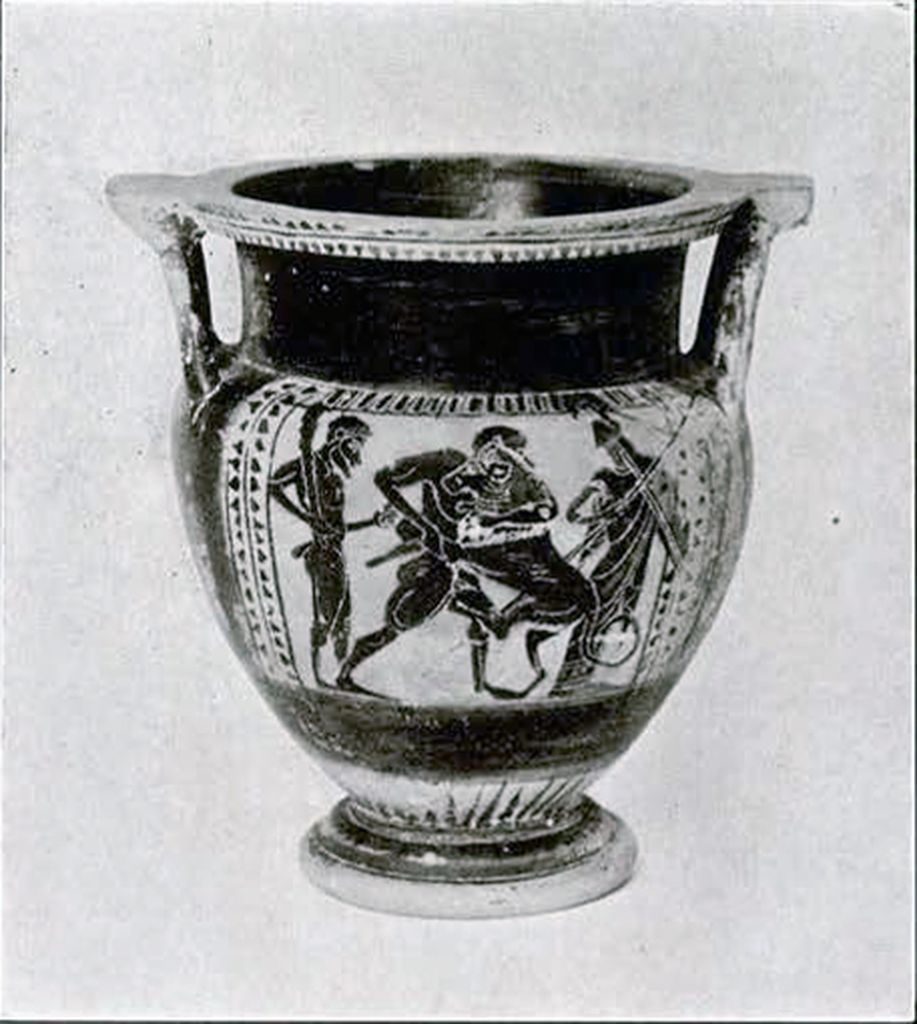
Museum Object Number: MS404
Image Number: 2728
This, the first of the labors of Herakles, has been reserved for the last one to be discussed, as it is the most popular of all the exploits of the hero in the Greek vase paintings. There are two ways in which this exploit is shown. In the earlier method, the liar is represented as rampant, and Herakles is represented as wrestling with him standing; in the other and later type, Herakles bends over the lion, who usually strikes at him with one of his hind paws There are five vases in the Museum, showing this combat, two in the earlier, three in the later manner. In the earlier type there are
- A very crude amphora of the black figured technique, at present not on exhibition (Figs. 58 and 59). On the obverse (Fig. 58), Herakles wrestles with the lion. He is nude, as he always is in these vases. At the left is his nephew and comrade Iolaos, who holds his club; he is also nude. On the right, a male and a female figure are represented, perhaps Athena and Hermes. The reverse (Fig. 59) has a design of draped figures and winged Victories.
- A black figured krater with column handles, said to have been found in one of the Greek Islands (Fig. 60). Herakles wrestles with the lion in the presence of Iolaos on the left and Athena on the right. On the reverse are four warriors, marching in procession.
The three vases of the later style are
- A black figured hydria, probably found at Chiusi. On the shoulder is a picture of Herakles and the Nemean Lion, in the presence of Athena and Iolaos (Fig. 61).
- Black figured panel amphora, found at Orvieto. On one side is Herakles fighting with the lion, in the presence of Athena and Iolaos; on the other a Bacchic scene. This excellent amphora, quite in the style of Exekias, has been published in the MUSEUM JOURNAL, Vol. VI, 1915, pp. 86 and 87, Figs. 65 and 66.
- I have selected, to conclude this article, a very beautiful black figured amphora from Corneto (Fig. 62). Herakles bends over the lion, who strikes at his face with his left hind paw. Behind the combatants stands Athena, encouraging the hero. This vase belongs in the best period of the black figured technique, and shows great skill in the use of incised line drawing. The reverse has been worn away, but seems to have shown Athena, Hermes and Herakles.
S.B.L.


